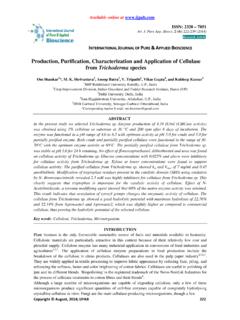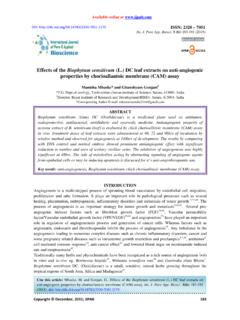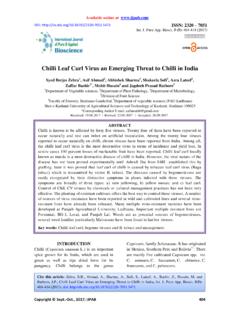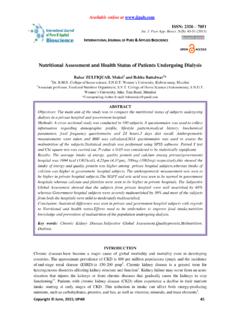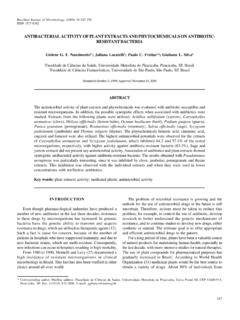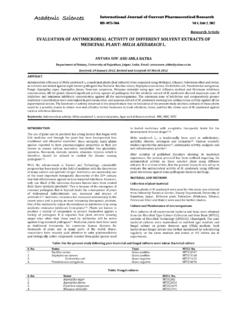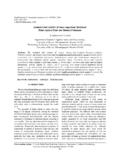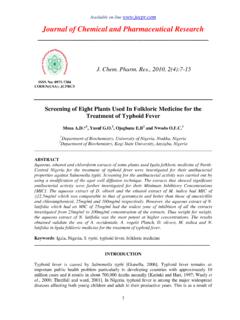Transcription of Antibacterial activity of Clove ( Syzygium …
1 Available online at ISSN: 2320 7051. Int. J. Pure App. Biosci. 2 (3): 305-311 (2014). Research Article INTERNATIONAL JOURNAL OF PURE & APPLIED BIOSCIENCE. Antibacterial activity of Clove ( Syzygium aromaticum) and Garlic (Allium sativum) on different pathogenic bacteria Yashab Kumar, Sakshi Agarwal, Abhinav Srivastava, Satyaprakash Kumar, Garima Agarwal and Mohammad Zeeshan Alam Khan*. Department of Microbiology & Fermentation Technology, Jacob School of Biotechnology & Bioengineering Sam Higginbottom Institute of Agriculture, Technology & Sciences (Deemed to be University). Allahabad- 211007 ( ) INDIA. *Corresponding Author E-mail: ABSTRACT. Antimicrobial activity of Clove ( Syzygium aromaticum) and Garlic (Allium sativum) was tested against two gram positive (Bacillus cereus and Staphylococcus aureus) and two gram negative (Salmonella typhi and Escherichia coli) pathogenic bacteria at different conc. (1000 ppm, 1500 ppm, 2000 ppm) of their extracts among which garlic was found to be more effective as compared to Clove .
2 Bacillus cereus was found to be most sensitive while was most resistant. Keywords: Antibacterial activity , parts per million (ppm), Syzygium aromaticum, Allium sativum, etc. INTRODUCTION. Spices have been used for many centuries by various cultures to enhance flavour and aroma of our foods as our ancestors have recognized the usage of spices in food preservation and in treatment of clinical ailments and there are several reports on development of antibiotic resistance in diverse bacterial pathogens4. This shift in susceptibility of pathogens to antibiotics greatly affects its ability to successfully treat patients empirically. Plant derived products have been used for medicinal purposes many centuries. At present it has been estimated that about 80% of the world population rely on botanical preparations as medicine to meet the needs as they are considered safe and provided to be effective against certain ailments5,6. Garlic has been used for centuries worldwide by various societies to combat infectious disease.
3 Garlic can be provided in the form of capsules and powders, as dietary supplements, and thus differ from conventional foods or food ingredients. Louis Pasteur was the first to describe the Antibacterial effect of onion and garlic juices. Allium vegetables, particularly garlic (Allium sativum L.) exhibit a broad antibiotic activity against both Gram-positive and Gram-negative bacteria. Therapeutic effect of garlic is possible because of its oil- and water-soluble organosulfur compounds, which are responsible for the typical odor and flavor of garlic. Thiosulfinates play an important role in the antibiotic activity of garlic3. Cloves are used in Ayurveda, Chinese medicine and Western herbalism. Cloves are used as a carminative, to increase hydrochloric acid in the stomach and to improve peristalis. It is also used in dentistry where the essential oil of Clove is used as anadyne for dental emergencies. In addition, the cloves are antimutagenic, anti-inflammatory, antioxidant, antiulcerogenic, antithrombotic and antiparasitic, Antibacterial and anti-inflmatory7.
4 This study has been done to determine the antimicrobial activity of Allium sativum (garlic) and Syzigium aromaticum ( Clove ) against certain pathogenic bacteria. 305. Moha. Zeeshan, A. K. et al Int. J. Pure App. Biosci. 2 (3): 305-311 (2014) ISSN: 2320 7051. MATERIAL AND METHOD. Place of work The present study entitled Antibacterial activity of Clove and garlic on different pathogenic bacteria was carried out in the Department of Microbiology and Fermentation Technology, Sam Higginbottom Institute of Agriculture, Technology & Sciences (Deemed-to-be-university), Allahabad. Test microorganisms The pathogenic organisms were obtained from the research laboratory of the department of Microbiology and Fermentation technology. The microbes used in this process were:- Bacillus cereus (MCCB-008). Staphylococcus aureus (MCCB-0065). Escherichia coli (MCCB-0018). Salmonella typhi (MCCB-0022). Preparation of the culture broth Nutrient broth was prepared and was inoculated with the test organism.
5 A loop full of microorganism was taken and inoculated in the NB and was incubated at 37oC for 24 hrs to obtain a viscous growth. Preparation of spices extracts The fresh spices samples ( Clove and garlic) used in the present study were obtained from the local market of Allahabad. They were collected and surface sterilized with HgCl2. Spices were then crushed with distilled water using mortar and pestle. The sample was then poured in sterilized centrifuge tubes and centrifuged at 3000 rpm for 15 min. The supernatant was taken and different concentrations (1000, 1500, and 2000 ppm) were made using sterile distilled water. Preparation of Nutrient agar plates The freshly prepared and autoclaved NA media was poured in the Petri plates, after cooling it to 45oC, and was kept to solidify. Cotton swabs were dipped in the culture broth and were swabbed on the solidified media surface. Antimicrobial sensitivity test using filter paper method Filter paper discs of 5 mm diameter were prepared and sterilized by dipping them in 95% ethanol using sterile forceps.
6 These discs were dipped aseptically in respective spices extract of appropriate concentration and placed over NA plates seeded with respective pathogens, with the help of sterile glass spreader. The plates were incubated in an upright position at 37 C for 24 h. The diameter of inhibition zones formed was measured in mm and the results were recorded. Discs with 7 mm diameter were considered as having no Antibacterial activity . Diameter between 7 and 12 were considered as moderatively active and those with > 12 mm were considered as highly active. RESULT AND DISSCUSSION. The Result of the present study entitled Antibacterial activities of Clove and garlic on different pathogenic bacteria were recorded according to the size of inhibition zone formed on the agar plates by disc diffusion method. Effect of garlic Extract Garlic showed excellent Antibacterial activity at all concentrations, that is, (1000, 1500 and 2000 ppm). It was found effective against the entire organism tested. The maximum effect was observed at 2000 ppm.
7 The Antibacterial effect decreases with decreasing concentration at 1000 ppm as it showed the minimum effect (table no. ). The maximum effect of garlic extract was shown on Bacillus cereus with maximum zone of inhibition and the minimum effect was shown in Escherichia coli. On Bacillus cereus the maximum zone of inhibition was 27mm at 2000 ppm concentration and Minimum zone of inhibition was 11mm at 1000 ppm concentration. On Staphylococcus aureus the maximum zone 306. Moha. Zeeshan, A. K. et al Int. J. Pure App. Biosci. 2 (3): 305-311 (2014). 2014) ISSN: 2320 7051. of inhibition was 24mm at 2000 ppm concentration and minimum zone of inhibition was 10mm at 1000. ppm concentration. On Salmonella typhi the maximum zone of inhibition was 19mm at 2000 ppm concentration and minimum zone of inhibition was 12mm at 1000 ppm concentration and on Escherichia coli the maximum zone of inhibition was 16mm at 2000 ppm concentration and minimum zone of inhibition was 8mm at 1000 ppm concentration concentration.
8 Table 3. 1 Comparative analysis of garlic extract on different strains of bacteria Zone of inhibition of Garlic extract at different Organisms concentration (mm) including 5 mm disc diameter. 2000 ppm 1500 ppm 1000 ppm Bacillus cereus 27 13 11. Staphylococcus aureus 24 13 10. Salmonella typhi 19 13 12. Escherichia coli 16 11 8. The Antibacterial activity of garlic is widely attributed to allicin. Allicin interferes with RNA production and lipid synthesis. If RNA cannot be produced, or produced in less amount then protein synthesis will be severely affected. It would be stopped at every stage due to the absence of messenger RNA, ribosomal RNA and transfer RNA. If amino acids and proteins cannot be produced then growth and development of the organism ism will not occur as they are essential for all parts of cell structure. Also, as lipid synthesis is affected, other parts of the cell are interfered with. The main effect being that the phospholipid biolayer of the cell wall cannot form correctly in both Gram positive and Gram negative bacteria.
9 All these things contribute to the bacteria cannot grow in the presence of allicin1, observed a significant bactericidal effect of garlic extract against Staphylococcus epidermidis, epidermidis Salmonella typhi and various yeasts. ye Even bacteria 3. resistant to antibiotic agents were sensitive to extracts of garlic . Comparative analysis of Garlic on different bacterial strains 30. 25. 20. 2000 ppm 15 1500 ppm 1000 ppm 10. 5. 0. B. cereus Effect of Clove Extract Clove showed comparatively lower effect on all the pathogenic strains of bacteria. Clove showed maximum effect on Salmonella typhi and minimum effect on (table ). On Bacillus cereus the maximum zone of inhibition was 23mm at 2000 ppm concentration concentratio and Minimum zone of inhibition was 9mm at 1000 ppm concentration. On Staphylococcus aureus the maximum zone of 307. Moha. Zeeshan, A. K. et al Int. J. Pure App. Biosci. 2 (3): 305-311 (2014). 2014) ISSN: 2320 7051. inhibition was at 2000 ppm concentration and minimum zone of inhibition was 8mm at 1000.
10 Ppm concentration. On Salmonella typhi the maximum zone of inhibition was 23mm at 2000 ppm concentration and minimum zone of inhibition was 10mm at 1000 ppm concentration concentration and on Escherichia coli the maximum zone of inhibition was 13mm at 2000 ppm concentration and minimum zone of inhibition was 7mm at 1000 ppm concentration. Table 3. 2 Comparative analysis of Clove extract on different strains of bacteria Zone of inhibition of Garlic extract at different Organisms concentration (mm) including 5 mm disc diameter. 2000 ppm 1500 ppm 1000 ppm Bacillus cereus 23 14 9. Staphylococcus aureus 12 8. Salmonella typhi 23 15 10. Escherichia coli 13 9 7. Comparative analysis of Clove on different bacterial strains 25. Diameter of inhibition Zone formed (in mm). 20. 15. 2000 ppm 1500 ppm 10 1000 ppm 5. 0. Cloves were used in Ayurveda, Chinese medicine and Western herbalism and also as a carminative, to increase hydrochloric acid in the stomach and to improve peristalsis. All the dilutions of Clove showed good inhibitory activity against all four bacteria.
